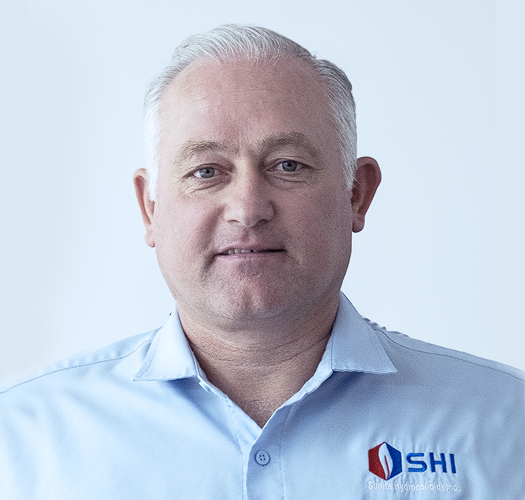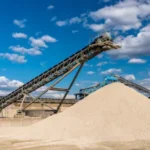How To Choose the Right Cementing Additives for Your Wellbore Conditions

Cementing additives are critical when it comes to well construction. A cement additive is a chemical solution designed to enhance the properties of cement slurry for oilfield applications, especially under extreme temperature and pressure conditions. They help control slurry behavior, lock in zonal isolation and protect casing from corrosion and pressure shifts.
Choosing the right oilfield cement additives for your specific wellbore conditions is what separates a successful cement job from one that risks integrity and remediation. From high pressure formations to reactive zones and temperature extremes, each environment demands a different slurry profile. Sunita Hydrocolloids is your trusted partner in this space.
With advanced cementing additives built for diverse oilfield conditions, we help operators build wells that hold. In this post, you will learn the key factors and cementing additive types that matter most so operators can make smart choices that support long term performance.
Understanding Cementing Additives and Their Importance
Cementing additives are chemical agents blended into cement slurry to modify its behavior during well construction. These chemicals play a crucial role in altering cement properties to meet the demands of various well environments. While base cement provides bulk strength, it lacks the flexibility to perform under complex wellbore conditions as high pressure, elevated temperatures, reactive formations and variable salinity, all demand specific formulations.
Specialized cements, combined with targeted additives, can enhance performance and address these challenges. Cement additives help control:
- Pumpability and rheology for smooth placement
- Setting time to match operational schedules
- Fluid loss to protect formations and maintain slurry integrity
- Strength development for long term durability and zonal isolation
Without the right additives, slurry can segregate, set too fast or fail to bond leading to poor isolation, casing damage and costly remediation.
Key Factors to Consider When Selecting Cementing Additives
Choosing the right wellbore cementing additives starts with understanding your well’s unique profile. Evaluate the performance characteristics of different additives to ensure they align with your well requirements. Also, consider the importance of the mix process and the role of mix water in preparing cement slurries with additives as proper blending and water selection are critical for optimal slurry performance.
Here’s what to look at before locking in your additive package:
Wellbore Temperature
High temperatures can accelerate cement hydration and weaken long term strength. Specialty retarders and strength retrogression inhibitors are essential for thermal stability in deep or geothermal wells. Some retarders are formulated with inorganic compounds to delay cement hydration in high temperature wells. Sunita’s high temperature additives are built to hold up under extreme heat without compromising pumpability.
Pressure Conditions
High pressure zones demand additives that maintain slurry integrity and prevent breakdown. Weighting agents and fluid loss control agents help manage pressure while supporting zonal isolation. Maintaining the mechanical properties of cement under high pressure is essential to ensure long term well integrity.
Additives are carefully selected to optimize cement performance, enhancing strength and durability in challenging pressure environments. Sunita’s formulations are designed to perform under stress and keep the cement sheath intact.
Well Depth
Deeper wells often mean higher temperature and pressure. That calls for a combination of retarders, dispersants and extenders that work together to ensure proper placement and long term durability. Managing thickening time is crucial in deep well cementing operations as it allows for sufficient placement time and helps maintain wellbore integrity under challenging conditions. Sunita’s specialty cementing additives are engineered for deep well reliability.
Formation Characteristics
Permeability and porosity affect how much fluid escapes into the formation. In weak formations, these properties can lead to increased risks, making it essential to reduce fluid loss to maintain wellbore stability. Fluid loss additives are key here. Chemical environment matters too. Sour gas zones with CO₂ or H₂S need additives with chemical resistance. Formation sensitivity requires compatibility to avoid damage or reaction.
Operational Constraints
Pumping time, mixing limitations and environmental regulations all influence additive selection. Whether you’re working with tight schedules or strict compliance standards, Sunita provides custom formulations based on detailed well data to meet your operational goals. It is important to select cost effective additive solutions that deliver high performance while staying within budget. Some additives are available in dry blended or liquid form to accommodate different mixing and operational requirements.
Common Cementing Additives and Their Functions
Choosing the right oilwell cementing additives starts with knowing what each type does and where it fits in your well design. Each cementing additive plays a crucial role in optimizing cement performance by improving strength, durability and structural integrity. The right combination of additives can significantly enhance cement performance, especially in challenging well conditions.
Here’s a breakdown of the most widely used additives:
Retarders
Retarders slow down cement hydration, giving crews more time to put slurry in high temperature wells where rapid setting is a risk. Common examples include lignosulfonates and hydroxycarboxylic acids. Sunita’s custom retarders are built for consistent performance across deep zones and thermal gradients.
Accelerators
Accelerators do the opposite, speeding up setting and early strength gain. Calcium chloride is a go to choice and Sunita’s accelerator blends are designed to reduce waiting on cement time without compromising long term integrity. Sodium chloride is another commonly used accelerator, typically added at 5-10% by weight of cement and dissolved in the mix water, which effectively reduces the thickening time of cement slurries. These accelerators play a crucial role in promoting early strength development, enabling faster wellbore stabilization and improved operational efficiency.
Fluid Loss Control Agents
Fluid loss can weaken cement and damage formations. Additives like hydroxyethyl cellulose, which act as fluid loss reducers, help control fluid loss and maintain slurry stability. Managing free water in the cement slurry is also crucial to prevent strength loss and operational issues. Sunita’s fluid loss control solutions are optimized for varied permeabilities and reactive zones.
Dispersants
Dispersants reduce slurry viscosity and improve flow. Polynaphthalene sulfonates are commonly used to prevent particle clumping. Dispersant additives are specifically used in cementing operations to improve slurry flow properties, decrease viscosity and control fluid loss. Additionally, dispersants promote turbulent flow at lower pump rates, enhancing cementing efficiency. Sunita’s dispersants support uniform placement and better rheology control.
Defoamers
Foam in the slurry leads to air pockets and weak cement. During cement slurry mixing, air entrainment can cause foaming, affect slurry density measurements and result in issues like inconsistent pumping. Silicone based defoamers eliminate bubbles and improve density. Defoamers work by altering surface tension which prevents foam formation and ensures accurate slurry measurements. Sunita’s defoamer additives ensure clean, bubble free slurry for consistent strength.
Extenders and Weighting Agents
Extenders like bentonite reduce slurry density for low pressure zones. Selecting appropriate particle sizes for extenders is crucial to ensure effective performance in cement slurries as different particle sizes help bridge fractures and weak zones. Weighting agents such as barite increase density to counteract high formation pressures. Sunita’s density modifiers help maintain wellbore stability and pressure control.
The Importance of Customized Cementing Additive Solutions
From formation chemistry to pressure profiles and temperature gradients, each well demands a cement slurry that’s built to match. That’s why customization matters.
Custom formulations help operators:
- Optimize slurry rheology for smooth placement
- Control setting time to match pumping schedules
- Minimize fluid loss and protect sensitive formations
- Boost compressive strength for long term well integrity
- Reduce operational risks and costs tied to remediation or failure
Tailored additive packages also enhance cement performance by improving mechanical strength and durability which is critical for achieving long term zonal isolation in oil and gas wells.
Testing and Validation of Cementing Additives
Before any cementing additive hits the field, it needs to prove itself in the lab. Testing under simulated downhole conditions is the only way to know how a slurry will behave when exposed to high pressure, elevated temperatures and reactive formations.
Key lab tests include:
- Setting time to ensure proper placement
- Compressive strength for long term durability
- Fluid loss control to protect formations and maintain slurry integrity
- Rheology testing to evaluate flow and pumpability
These tests help operators avoid cementing failures like channeling, poor bonding or premature setting. Sunita Hydrocolloids is committed to rigorous quality control and technical validation. Our additives are tested across a range of conditions to ensure consistent performance in the cementing additive market.
Impact of Proper Cementing Additive Selection on Well Performance
Getting the oilfield cementing additives right is more than a technical detail; it’s a performance driver. The right blend helps form a strong, impermeable cement sheath that locks in zonal isolation and shields casing from corrosive fluids and mechanical stress. That means fewer remedial jobs, smoother slurry placement and reduced waiting on cement time.
Operational efficiency improves when slurry behaves as expected. Sunita Hydrocolloids delivers oil well cementing additives built for performance. With custom formulations and technical support, we help operators match chemistry to well conditions.
Why Choose Sunita Hydrocolloids for Cementing Additives?
Sunita Hydrocolloids brings over 40 years of chemical innovation to the oilfield. Our cementing additives are trusted across North and South America for their reliability, performance and field proven results. We specialize in custom formulations that match your well’s temperature, pressure and formation profile.
Every batch is backed by strict quality assurance and tested for consistency. With a USA based distribution center in Houston, we ensure fast delivery and responsive support so your operations stay on track. Committed to environmentally safe chemistry, we offer low VOC and biodegradable options that meet evolving regulatory standards.
Conclusion
Choosing the right cementing additives is a critical step in building wells that last. It’s not just about chemistry but reliability. Sunita Hydrocolloids delivers cementing additives built for performance, backed by decades of oilfield expertise and custom formulation capabilities.
Whether you’re working in high temperature zones or low permeability formations, we help you match the slurry to the challenge. Need help selecting the right additives? Talk to our technical team and get a solution that fits your well.





